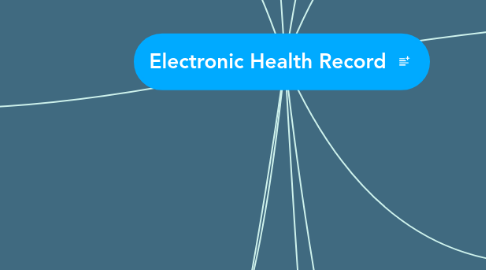
1. Concept
1.1. EHR can be used in an ambulatory care setting, providing physicians with the ability to carefully monitor their patients health over time, and allowing them to prevent medical errors, including misdiagnoses (Coughlin, 2013).
1.2. EHR when used in an inpatient setting, like a hospital, typically serves as a ‘hub’ for all the information health care providers need. An EHR in this setting will be interoperable with other systems within the setting (and not external connections) such as a radiology information system, laboratory information system, and a billing system (Rowley, 2017).
2. Misconception
2.1. One of the common misconceptions with EHRs includes how they are commonly used interchangeably with electronic medical records (EMRs), even though the two terms are entirely different from one another.
2.1.1. With EHRs, these contain a more complete record of patient data and allows for the sharing of data across multiple healthcare providers (Heart, Ben-Assuli, & Shabtai, 2017).
2.1.2. Whereas with EMRs, these platforms are utilized to only store institutional data which means that they only contain limited patient medical history (Heart, Ben-Assuli, & Shabtai, 2017).
2.2. Another misconception involves how some individuals believe that there is a one-size fits all approach with EHRs that can be utilized in any given healthcare setting.
2.2.1. This misconception is far from the truth, as each EHR has to be tailored to meet the needs of the setting in which it is implemented.
3. Essential Features
3.1. 1. Requires a secure internet connection
3.1.1. Without this feature, an EHR will be unable to successfully bring in data from other systems.
3.2. 2. Charting patient records
3.2.1. Being one of the primary features of an EHR, the absence of charting patient records would make using an EHR impractical.
3.3. 3. Accessible 24/7 by authorized users
3.3.1. This feature is necessary due to situations of emergency when providers must pull up a patient’s file to check their health history, including medications and allergies. (i.e. in instance of emergency being able to pull up a patient’s file immediately to check what medication they are currently on and if they have any allergies - authentication)
4. Learning Outcomes
4.1. 1. The role EHRs play to impact patient outcomes
4.2. 2. Identify the barriers and challenges associated with the hesitance to use EHRs
4.3. 3. Understanding the difference between an EMR and EHR
4.4. 4. Realize the importance behind proper standardized training protocols with EHRs to ensure their optimal effectiveness
5. Learning Resources
5.1. 1. YouTube videos
5.1.1. Sharing Your Electronic Health Record (EHR) https://www.youtube.com/watch?v=88XuX-AFBwY
5.1.2. EMR/EHR Done Right https://www.youtube.com/watch?v=97v5p9Nk2_I
5.1.3. EHRs in 2028 - What should the future look like? - 2018 EHR National Symposium -Stanford Medicine https://www.youtube.com/watch?v=CtsUtqdFNCo
5.1.4. Why electronic health records? https://www.youtube.com/watch?v=Lo_3qOejQzI
5.1.5. Electronic Health Records: Usability and Unintended Safety Issues https://www.youtube.com/watch?v=SlQ60KaLeHg
5.2. 2. Scholarly articles (accessible through the UVic library)
5.2.1. Measuring interoperable EHR adoption and maturity: a Canadian example http://web.b.ebscohost.com.ezproxy.library.uvic.ca/ehost/pdfviewer/pdfviewer?vid=2&sid=4bfb2b80-4311-45e4-bb89-336530bd226e%40pdc-v-sessmgr02
5.2.2. Users' perspectives of barriers and facilitators to implementing EHR in Canada: A study protocol https://implementationscience-biomedcentral-com.ezproxy.library.uvic.ca/articles/10.1186/1748-5908-4-20
5.2.3. The value of connected health information: perceptions of electronic health record users in Canada http://web.b.ebscohost.com.ezproxy.library.uvic.ca/ehost/pdfviewer/pdfviewer?vid=1&sid=ebf35305-22f3-4f50-9038-4cb452466a9a%40pdc-v-sessmgr02
5.2.4. Adoption of electronic health records and barriers https://www.tandfonline.com/doi/full/10.3402/jchimp.v6.32643?scroll=top&needAccess=true
5.2.5. Educating Health Professionals about the Electronic Health Record (EHR): Removing the Barriers to Adoption https://dspace.library.uvic.ca//handle/1828/6519
5.3. 3. 'Grey Literature' (professional resources, blogs, videos, etc.)
5.3.1. Electronic Health Records - Canada Health Infoway - https://www.infoway-inforoute.ca/en/solutions/digital-health-foundation/electronic-health-records
5.3.2. Understanding EHRs, EMRs and PHRs - Canada Health Infoway - https://www.infoway-inforoute.ca/en/solutions/digital-health-foundation/understanding-ehrs-emrs-and-phrs
5.3.3. A national electronic health record for all Canadians https://www.cbc.ca/radio/whitecoat/a-national-electronic-health-record-for-all-canadians-1.4976932
5.4. 4. Technology tools (WordPress, Etherpad, Moodle, etc.)
5.4.1. OpenEMR (Open source platform) https://www.open-emr.org/demo/
5.4.2. WordPress
6. Description of purposed learning resource
6.1. Within the context of the healthcare industry, it is critical to understand how health information technologies (HITs) such as electronic health records (EHRs) are impacting the delivery of patient care.
6.1.1. More specifically, EHRs are a “repository of patient data in digital form, stored and exchanged securely, and accessible by multiple authorized users” (Häyrinen, Saranto, & Nykänen, 2007:2008)
7. Definition
7.1. “a longitudinal record in digital format containing a range of patient data including demographics, medical history, radiology images, medications and allergies, generated by one or more clinical encounters in various health care delivery settings” (American Optometric Association, 2011; Heart, Ben-Assuli, & Shabtai, 2017)
8. Accidental Features
8.1. 1. Interoperability
8.1.1. Facilitates secure information sharing between healthcare networks
8.1.1.1. In doing so, this accidental feature “enable(s) the sharing of data and information about patients׳ medical and health history” (Heart, Ben-Assuli, & Shabtai, 2017).
8.1.2. Extremely situational and depends on the available resources of the healthcare setting
8.1.2.1. For example, if a hospital does not have strong Wi-Fi connection around the entire facility, then the feature of an EHR being compatible on mobile devices would likely not be possible.
8.2. 2. Mobile compatibility
8.3. 3. Clinical Decision Support
8.3.1. A potential feature within EHRs that enhances clinical decision based on predefined algorithms and rules to assist providers in the delivery of care (Jannetti, 2013).

